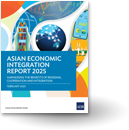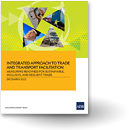Trade Resilience: Four Strategies for Strengthening Supply Chains in Asia and the Pacific
As global economic corridors gain momentum, a comprehensive approach to trade and transport facilitation is essential to strengthen supply chains for sustainable growth.
International economic corridors have been a topic of significant discussion in global forums. Notably, the United States and India announced the India-Middle East-Europe Economic Corridor during the G20 Summit. Additionally, India proposed another corridor connecting Southeast Asia, India, West Asia, and Europe at the ASEAN-India Summit.
Asian nations have long pursued such corridors under various regional cooperation initiatives, like the Greater Mekong Subregion, Central Asia Regional Economic Cooperation Program, Bay of Bengal Initiative, and the Belt and Road Initiative.
This underscores the increasing significance of cross-country connectivity to enhance trade, investment and regional cooperation.
Trade facilitation is now more crucial than ever and merits a broader approach for supply chain resilience. It is essential to understand the complementary role of transport connectivity, that covers hard infrastructure and international regulations, and trade facilitation, which includes at the border customs procedures and infrastructure. While the importance of each of these in boosting trade is undeniable, the connection between transport and trade facilitation in policy discussions isn’t always evident.
Typically, trade facilitation is discussed within the World Trade Organization’s Trade Facilitation Agreement focusing on border measures and customs cooperation. The same policy document discusses transport in a limited way under freedom of transit and border agency cooperation. Transport cooperation, at the regional or international level, is discussed in separate forums like the Asian Highway Network, ASEAN agreement on inter-state transport, BBIN Motor Vehicle Agreement with wide variation in coverage and commitments in traffic regulations and infrastructure standards. There seems to be a dichotomy in policy planning and discussion with regard to trade and transport connectivity that often results in a sub-optimal outcome.
This is reflected in a 2021 World Trade Organization (WTO) study. It highlighted that transport costs and regulatory differences among countries account for 29% and 16% of the overall trade cost. The issue is particularly acute for landlocked countries like Bhutan, the Lao People’s Democratic Republic, and Mongolia, which depend on their neighbors’ trading gateways. This indicates that while trade infrastructure has been a focus for a while, a more enhanced and comprehensive approach to supply chain connectivity, encompassing both border and transport infrastructure and policies, is needed. This is a key finding of the recent ADB report Integrated Approach to Trade and Transport Facilitation.
Economies across Asia and the Pacific are seeking to increase trade within and outside of the region.
Recommendations for addressing these challenges include:
Enhanced Coordination: Countries must coordinate internally and externally to develop trade infrastructure. A unified approach is vital for efficient trade and transport facilitation. Often, transport connectivity and customs facilities are disjointed, leading to inefficiencies. Bilateral coordination is also essential, especially for countries sharing borders, to ensure synchronized development and avoid supply chain disruptions.
Unified Policy Approach: Regional trade policies should integrate trade facilitation and transport cooperation. The ADB report suggests that while customs procedures are well-covered in policy documents, transport connectivity often isn’t. Separate discussions on cross-country transport operations need to be integrated for a cohesive trade strategy.
Inclusion and Sustainability: Trade facilitation policies in Asia and the Pacific should incorporate gender mainstreaming, inclusivity, and climate change considerations. As countries adopt eco-friendly trade measures, these aspects become even more critical.
Digital Advancements: Countries should accelerate the implementation of WTO Trade Facilitation Agreement measures and adopt ‘paperless trade’ practices. The pandemic highlighted the importance of digital trade facilitation. Adopting frameworks like UNESCAP’s agreement on cross-border paperless trade can address supply chain disruptions and promote resilient, sustainable, and inclusive trade.
While the commitment to developing international economic corridors is commendable, countries must address past challenges. Beyond facilitating trade, modern transport and trade integration should also prioritize countries’ policy objectives of decarbonization, inclusivity, and technological advancements.
Economies across Asia and the Pacific are seeking to increase trade within and outside of the region. Broader coverage, aligning with supply chains, and comprehensive cooperation between transport and trade facilitation is needed to support these efforts.
Original article was published at the Asian Development Blog and duplicated here with permission from the author. *




